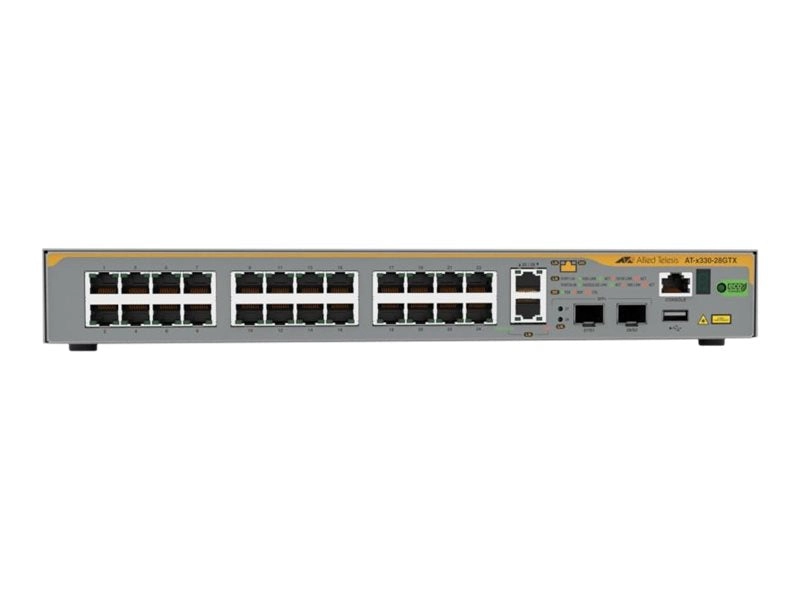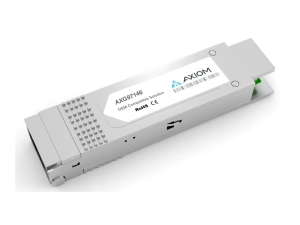Product Details
+
Allied Telesis AT x330-28GTX - Switch - L3 - managed - 24 x 10/100/1000 2 x 1/2.5/5/10GBase-T 2 x 1 Gigabit / 10 Gigabit SFP - rack-mountable
The Allied Telesis x330 Series provide an excellent access solution supporting Gigabit to the desktop for maximum performance. With MultiGigabit and 10 Gigabit copper and fiber uplinks, and a fanless design for silent operation, the x330 Series are ideal for the edge of business networks in the IoT era. With support for Layer 3 routing protocols, the x330 Series can also be deployed as distribution or small branch office core switches.
What's in the Box:
- Allied Telesis Autonomous Management FrameworkTM (AMF)
AMF is a sophisticated suite of management tools that provide a simplified approach to network management. Common tasks are automated or made so simple that the every-day running of a network can be achieved without the need for highly-trained, and expensive, network engineers. Powerful features like centralized management, auto-backup, auto-upgrade, auto-provisioning and auto-recovery enable plug-and-play networking and zero-touch management. - Virtual Chassis Stacking (VCStackTM)
The x330-20GTX and x330-28GTX can form a VCStack of up to six switches, with 40 Gbps of stacking bandwidth. VCStack provides a highlyavailable system in which network resources are spread out across stacked units, minimizing the impact should any unit fail. - Ethernet Protection Switched Ring (EPSRingTM)
EPSRing allows several x330 switches to join a protected ring capable of recovery within as little as 50ms. This feature is perfect for high availability in enterprise networks. The x330 Series can act as the ESPR Master, or be deployed as an EPSR transit node. - G. 8032 Ethernet Ring Protection
G. 8032 provides standards-based high-speed ring protection, that can be deployed stand-alone, or interoperate with Allied Telesis EPSR. Ethernet Connectivity Fault Monitoring (CFM) proactively monitors links and VLANs, and provides alerts when a fault is detected. - Access Control Lists (ACLs)
The x330 Series feature industry-standard access control functionality through ACLs. ACLs filter network traffic to control whether packets are forwarded or blocked at the port interface. This provides a powerful network security mechanism to select the types of traffic to be analyzed, forwarded, or influenced in some way. An example of this would be to provide traffic flow control. - VLAN ACLs
Simplify access and traffic control across entire segments of the network. Access Control Lists (ACLs) can be applied to a Virtual LAN (VLAN) as well as a specific port. - Upstream Forwarding Only (UFO)
UFO lets you manage which ports in a VLAN can communicate with each other, and which only have upstream access to services, for secure multi-user deployment. - Easy to manage
The AlliedWare Plus operating system incorporates an industry standard CLI, facilitating intuitive manageability. With three distinct modes, the CLI is very secure, and the use of SSHv2 encrypted and strongly authenticated remote login sessions ensures CLI access is not compromised. As a Layer 3 switch, a static route can be added to allow a user in a different subnet to manage the switch. The Device GUI enables graphical monitoring and management of the switch, simplifying administration. - Open Shortest Path First (OSPFv2, OSPFv3)
OSPF is a scalable and adaptive routing protocol for IP networks. The addition of OSPFv3 provides support for IPv6 and further strength for next generation networking. - Storm protection
Advanced packet storm control features protect the network from broadcast storms: Bandwidth limiting minimizes the effects of the storm by reducing the amount of flooding traffic. Policy-based storm protection is more powerful than bandwidth limiting. It restricts storm damage to within the storming VLAN, and it provides the flexibility to define the traffic rate that creates a broadcast storm. The action the device should take when it detects a storm can be configured, such as disabling the port from the VLAN or shutting the port down. Packet storm protection allows limits to be set on the broadcast reception rate, multicast frames and destination lookup failures. In addition, separate limits can be set to specify when the device will discard each of the different packet types. - sFlow
sFlow is an industry-standard technology for monitoring high-speed switched networks. It provides complete visibility into network use, enabling performance optimization, usage accounting/billing, and defense against security threats. Sampled packets sent to a collector ensure a real-time view of network traffic. - Loop protection
Thrash limiting, also known as Rapid MAC movement, detects and resolves network loops. It is highly user-configurable - from the rate of looping traffic to the type of action the switch should take when it detects a loop. With thrash limiting, the switch only detects a loop when a storm has occurred, which can potentially cause disruption to the network. To avoid this, loop detection works in conjunction with thrash limiting to send special packets, called Loop Detection Frames (LDF), that the switch listens for. If a port receives an LDF packet, one can choose to disable the port, disable the link, or send an SNMP trap. - Tri-authentication
Authentication options on the x330 Series include alternatives to 802.1x port-based authentication, such as web authentication, to enable guest access and MAC authentication for end points that do not have an 802.1x supplicant. All three authentication methods - 802.1x, MAC-based and Web-based - can be enabled simultaneously on the same port, resulting in tri-authentication. - TACACS Command Authorization
TACACS Command Authorization offers centralized control over which commands may be issued by each specific AlliedWare Plus device user. It complements authentication and accounting services for a complete AAA solution. - Premium Software License
By default, the x330 Series offer a comprehensive Layer 2 and basic Layer 3 feature set that includes static routing and IPv6 management features. The feature set can easily be elevated to full Layer 3 by applying the premium software license. This adds dynamic routing protocols and Layer 3 multicasting capabilities. - Unidirectional Link Detection
Unidirectional Link Detection (UDLD) is useful for monitoring fiber-optic links between two switches that use two single-direction fibers to transmit and receive packets. UDLD prevents traffic from being sent across a bad link by blocking the ports at both ends of the link in the event that either the individual transmitter or receiver for that connection fails. - Active Fiber Monitoring
Active Fiber Monitoring prevents eavesdropping on fiber communications by monitoring received optical power. If an intrusion is detected, the link can be automatically shut down, or an operator alert can be sent. - Multicast Source Discovery Protocol (MSDP)
MSDP enables two or more PIM-SM (Sparse Mode) domains to share information on active multicast sources, for more efficient forwarding of multicast traffic. - Link Monitoring (Linkmon)
Linkmon enables network health monitoring by regularly sending probes over key links to gather metrics comprising latency, jitter, and probe loss. This supports pro-active network management, and can also be used with triggers to automate a change to device or network configuration in response to the declining health of a monitored link. - VLAN Translation
VLAN Translation allows traffic arriving on a VLAN to be mapped to a different VLAN on the outgoing interface. Service Providers can provide customers with a unique VLAN ID, which can be changed for data transfer through the SP's network. In the Enterprise, it can be used to merge two networks together, without manually reconfiguring the VLAN numbering scheme.
The Allied Telesis x330 Series provide an excellent access solution supporting Gigabit to the desktop for maximum performance. With MultiGigabit and 10 Gigabit copper and fiber uplinks, and a fanless design for silent operation, the x330 Series are ideal for the edge of business networks in the IoT era. With support for Layer 3 routing protocols, the x330 Series can also be deployed as distribution or small branch office core switches.
- AlliedWare Plus Enterprise-class operating system
- Allied Telesis Autonomous Management Framework (AMF)
- Vista Manager EX compatible
- AMF-Security compatible
- 10 G copper and fiber uplinks
- EPSRing and G.8032 for resilient rings
- EPSR Master
- Energy Efficient Ethernet saves power
- Upstream Forwarding Only (UFO)
- Active Fiber Monitoring
- Static and dynamic routing
- Fanless design for silent operation
- Web-based Device GUI
- Multicast Source Discovery Protocol (MSDP)
- Link Monitoring
What's in the Box:
- Allied Telesis AT x330-28GTX
- RJ-45 to DB-9 cable















